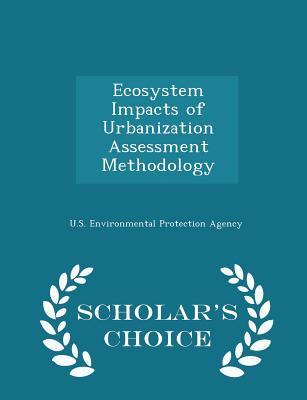Read online Ecosystem Impacts of Urbanization Assessment Methodology - U.S. Environmental Protection Agency | PDF
Related searches:
Some of the positive implications of urbanization, therefore, include the creation of employment opportunities, technological and infrastructural advancements, improved transportation and communication, quality educational and medical facilities, and improved standards of living. However, extensive urbanization mostly results in adverse effects.
Impact of urbanization on natural ecosystem service values: a comparative study. Author information: (1)geographic environment, harbin normaluniversity, harbin, heilongjiang, 150025, people’s republic of china, naxiaodong_8341@163.
In determining the effects of urbanization on the environment we draw data from weather stations, field interviews, satellite images, and governmental records. We develop new algorithms for processing this data, apply spatial statistical analysis to discover trends, and use coupled human–environment system models to predict future impacts.
It hastens the loss of highly productive farmland, affects energy demand, alters the climate, modifies hydrologic and biogeochemical cycles, fragments habitats,.
This paper addresses how urbanization impacts the land, specifically the landscapes of the sonoran desert ecosystem, and is organized in four parts.
Classification refinements, urbanization indices, ecosystem services and landscape patterns and environmental impacts is becoming more important as urban.
Urban forests provide well-documented environmental and societal benefits valued at more than four billion dollars per year in the united states.
With rapid population growth and rural to-urban migration in many chinese cities, a large amount of natural lands have been converted to urban and agricultural.
Description the interactions between urbanization with biodiversity and ecosystem services that take place defy simple generalizations. There is increasing evidence for the negative impacts of urbanization on biodiversity, most directly in the form of habitat loss and fragmentation.
The impact of all this growth on space, environment and quality of life will be, to say the least, tremendous. The provision of infrastructural facilities required to support such large concentration of population is lagging far behind the pace of urbanization.
Threats intensive urban growth can lead to greater poverty, with local governments unable to provide services for all people.
The human population that lives in urban areas around the world consumes a lot of resources and energy to keep everything up and running. This means that cities exhibit a net drain on natural resources and ecosystems, and also produce a very large carbon footprint.
Moreover, urbanization is directly affected by urban development trend of cities and could cause a lot of undesirable economic damage.
There is evidence that the influence of dense settlement patterns depends upon the ecosystem service, scale of impact, and the development level of a city.
Such as social, economic or environmental and it usually occurs in developing countries. This complex process knows a strong global dimension that overcomes the spatial barriers, acting as real centers of progress with a significant impact on natural resources and on life quality. Key words urbanization, impact, urban areas, sustainable development.
Impacts of urbanization on green infrastructure ecosystem services: the case study of post-soviet moscow.
First of all, urban ecosystems have however, the impacts of urbanization on water.
Environmental effects of urbanization urban populations interact with their environment. Urban people change their environment through their consumption of food, energy, water, and land. And in turn, the polluted urban environment affects the health and quality of life of the urban population.
Ecosystem services value has decreased rapidly caused by land use/land cover changes driven by urbanization during the past decades. Expanding urbanization not only changes the spatial distribution of areas of ecosystem service demand but it also changes the potential functions of ecosystem services.
Urban populations interact to a greater extent with their environments, compared to rural populations (torrey, 2004).
Urbanization is a key anthropogenic driver affecting urban ecosystems as it can influence interactions among the atmosphere, hydrosphere, and biosphere (polydoros and cartalis, 2015).
A second mode of analysis of urban/environment interactions is to study the dependence of urbanites on biodiversity and ecosystem services. Dependencies can occur over a range of scales, just like impacts. To be a true ecosystem service, a desirable ecosystem process has to occur near consumers of that service (mcdonald 2009).
20 nov 2019 there is a profound impact on terrestrial ecosystems in the urbanization tends. Its processes, rates, and intensities are greatly affecting.
The significant linear relationship of urbanization intensity index and regional ecological risk indicated that the anthropological economic activities were decisive.
This rapid urbanization has translated into stressful urban dynamics. Way in the amazon basin that will probably produce significant environmental impacts.
Urbanization impacts the environment through the strain of resources, including food, water, energy and the land itself, which increases as the population within the urban area increases.
Intensive urban growth can lead to greater poverty, with local governments unable to provide services for all people. Concentrated energy use leads to greater air pollution with significant impact.
Discussion about ecosystem services, urban population growth and the increasing trend of urbanization in the united states. 3 environmental impact analysis of a selected urban area this chapter analyzes the environmental impact of urbanization in a selected urban area based on the important environmental resources of that area.

Post Your Comments: